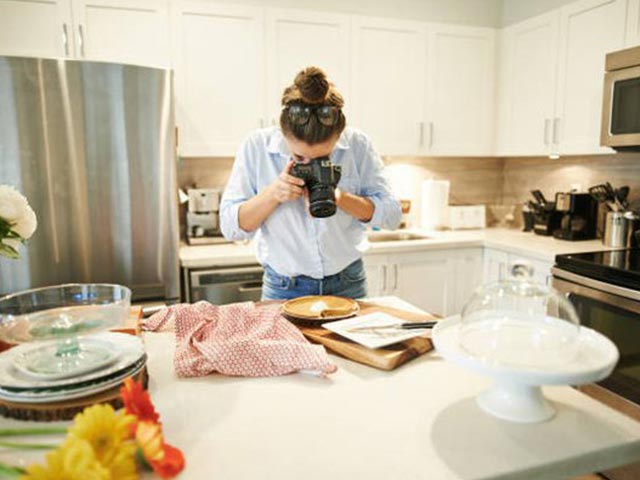Product Photography Services by 4DEE Technologies | High-Quality Imaging Solutions
Photography is the talent, application and repetition of creating long-lifelong images by footage light or other electromagnetic radiation, either electronically by means of an image sensor, or chemically by means of a light-sensitive material such as photographic film.
It is working in many fields of science, modern (e.g., photolithography), and business, as well as its more direct uses for art, film and video creation, recreational purposes, hobby, and mass communication.

Product Photography Works
Usually, a lens is used to focus the light reflected or emitted from objects into a real image on the light-sensitive surface inside a camera during a timed exposure. With an electronic image sensor, this produces an electrical charge at each pixel, which is electronically processed and stored in a digital image file for following display or processing.
The result with photographic mix is an invisible latent image, which is later chemically “developed” into a discernible image, either negative or positive depending on the purpose of the photographic objects and the method of processing. A negative image on film is conventionally used to photographically create a positive image on a paper base, known as a print, either by using an enlarger or by contact printing.
Some people may have coined the same new term from these roots by yourself. Hercules Florence, a French painter and inventor living in Campinas, Brazil, used the French form of the word, photography, in private notes which a Brazilian historian believes were written in 1834. This claim is widely reported but is not yet largely recognised internationally. The first use of the word by the Franco-Brazilian inventor became widely known after the research of Boris Kossoy in 1980.
Usually, a lens is used to focus the light reflected or emitted from objects into a real image on the light-sensitive surface inside a camera during a timed exposure. An electronic image sensor, produces an electrical charge at each pixel, which is electronically processed and stored in a digital image file for following display or processing.
The result with a photographic mix is an invisible latent image, which is later chemically “developed” into a discernible image, either negative or positive depending on the purpose of the photographic objects and the method of processing. A negative image on film is conventionally used to photographically create a positive image on a paper base, known as a print, either by using an enlarger or by contact printing.
Some people may have coined the same new term from these roots by themselves. Hercules Florence, a French painter and inventor living in Campinas, Brazil, used the French form of the word, photography, in private notes which a Brazilian historian believes were written in 1834. This claim is widely reported but is not yet largely recognized internationally. The first use of the word by the Franco-Brazilian inventor became widely known after the research of Boris Kossoy in 1980.
Product Photography
The German newspaper Vossische Zeitung of 25 February 1839 contained an article entitled Photography, discussing several priority claims – especially Henry Fox Talbot’s – regarding Daguerre’s claim of invention. The article is the earliest known occurrence of the word in public print.
It was signed “J.M.”, believed to have been Berlin astronomer Johann von Meddler. The astronomer Sir John Herschel is also credited with coining the word, independent of Talbot, in 1839.
Also, product photography is an art, and it’s a skill that can be taught. If you already have a good eye and some experience with photography, you’ll find that product photography is not only easy to learn, but also highly rewarding.
- You’ll be able to earn money for your work by selling prints, creating stock photos that can be purchased and used commercially by other people or businesses, and even working with companies directly to take photos of their products for their catalogs, websites, or other media.
- As long as you have the basic skills and equipment you need for standard photography—such as a camera, lens, light source, tripod or stand for your camera, editing software—you’re ready to start learning about product photography.
How To Do Product Photography With Less Equipment?
Most photographers work from home or in studios where they can control the environment and make it easier for them to capture the best possible shots.
Also, it’s important to have images that show your products in a realistic way. Product photography is an art, created by people who take photos of products for magazines, catalogs, brochures, and so on. Moreover, there are different styles of product photography, each with its own rules and techniques.
Product photographers need to be able to use technical equipment such as lighting rigs, tripods, and other camera accessories. Hence, they must also learn various photo editing techniques. A product photographer should be able to produce high-quality images of products under different lighting conditions.
1. What is event management? Event management involves planning, organizing, and executing various types of events, such as conferences, weddings, corporate meetings, trade shows, and more, to ensure they run smoothly and successfully.
2. Why do I need an event management company? Event management companies bring expertise and experience to handle the complex logistics, coordination, and details of events, allowing you to focus on your goals and enjoy a stress-free event.
3. What types of events do event management companies handle? Event management companies handle a wide range of events, including corporate events, weddings, product launches, festivals, charity fundraisers, seminars, and cultural gatherings.
4. How involved will I be in the event planning process? The level of involvement can be tailored to your preferences. Event management companies can handle every aspect of planning or work closely with you to ensure your vision and requirements are met.
5. How do you handle event budgets? Event management companies work with you to establish a budget, allocate funds to different components, and ensure efficient spending while maintaining quality and meeting your event’s objectives.
6. What services do event management companies provide? Event management companies offer a range of services, including venue selection, vendor coordination, logistics management, event promotion, guest registration, on-site coordination, and post-event analysis.
7. How do you ensure the event’s success on the actual day? On the event day, the management team oversees all logistics, manages vendors, handles any unexpected issues, ensures timely setup, and coordinates the flow of the event to ensure a seamless experience.
8. Can you help with virtual or hybrid events? Yes, many event management companies have adapted to the digital landscape and can assist with planning and executing virtual or hybrid events, integrating online and offline experiences.
9. How far in advance should I book your services for my event? Booking timelines can vary based on the size and complexity of the event. It’s advisable to reach out to an event management company as soon as you have a date in mind to secure their availability.
10. How can I get in touch to discuss my event’s requirements? You can easily get in touch with us through our website or by phone. We’ll schedule an initial consultation to discuss your event’s goals, requirements, and any specific ideas you have in mind.
Feel free to tailor these questions to align with the specific services and focus of your event management company.
Absolutely, here are 10 frequently asked questions (FAQs) related to product photography:
1. What is product photography? Product photography is the practice of capturing high-quality images of products for marketing, advertising, e-commerce, and promotional purposes.
2. Why is professional product photography important? Professional product photography enhances your brand’s image, showcases your products in the best light, and helps attract customers’ attention, leading to increased sales and engagement.
3. What type of products can benefit from professional photography? Virtually any type of product can benefit from professional photography, including clothing, electronics, food, jewelry, cosmetics, home goods, and more.
4. How do I prepare my products for a photoshoot? Preparing products involves cleaning and styling them, ensuring they are in pristine condition, and providing any relevant information to the photographer about desired angles and details.
5. What equipment do product photographers use? Product photographers typically use professional cameras, lenses, lighting equipment, backdrops, and props to achieve the desired look and quality for your product images.
6. Can you help with styling and arranging products for the shoot? Yes, many product photographers offer styling services to ensure your products are presented in an aesthetically pleasing and cohesive manner.
7. What is the difference between white background and lifestyle product photography? White background product photography focuses on isolating the product on a clean, plain background, while lifestyle product photography involves placing the product in real-life scenarios to showcase its use and context.
8. How long does a typical product photoshoot take? The duration of a product photoshoot depends on the number of products, complexity of shots, and specific requirements. Simple shoots may take a few hours, while larger projects can span over several days.
9. Can you accommodate specific branding and style guidelines? Yes, professional product photographers work closely with clients to understand their brand identity and guidelines, ensuring the images align with the desired aesthetic.
10. How can I use the product images after the photoshoot? You can use the product images for various purposes, including e-commerce websites, social media, print materials, advertisements, and marketing campaigns, helping to showcase your products to a wider audience.
Feel free to customize these questions to match your product photography business’s specific services and focus.
